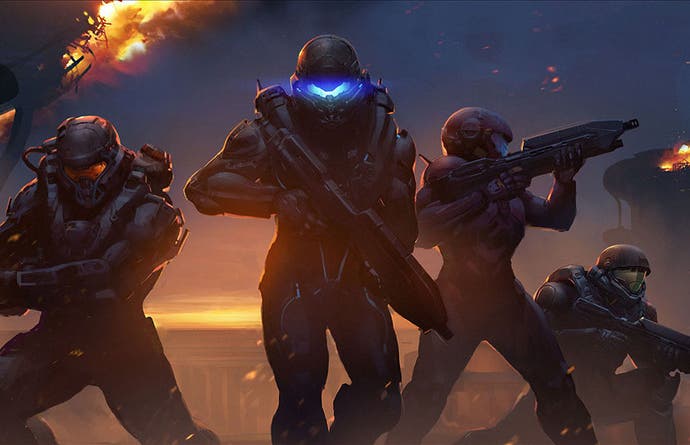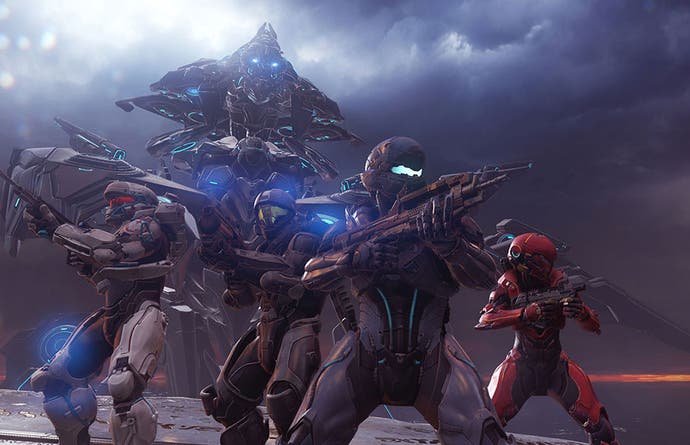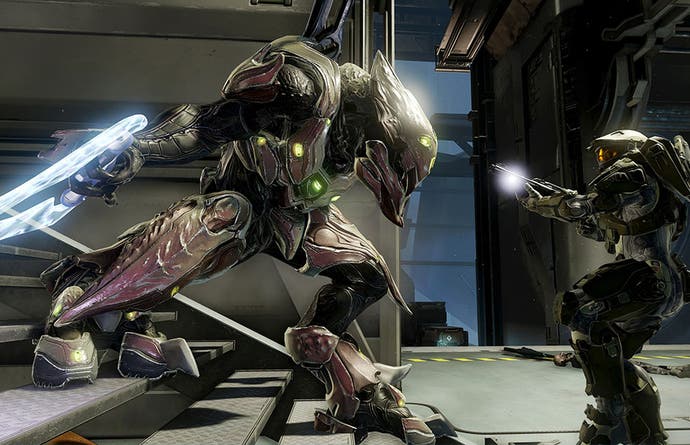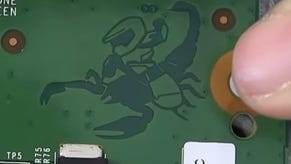Halo 5's campaign goes back to basics - and it's all the better for it
Olly olly oxen free.
Playing Halo 5's campaign, you get the feeling developer 343 is being pulled in two opposing directions: one direction heads towards the tried and trusted Halo gameplay perfected by Bungie before Microsoft took over development duties after the release of Halo: Reach, the other direction heads towards a need to grow the Halo franchise while establishing new characters.
Where does Halo 5's meaty, crisp and fun campaign end up? Further along the gameplay road than the story road.
Let's start with the story. In the build up to the release of Halo 5, Microsoft's marketing has zeroed in on an apparent conflict between Master Chief, the series star, and a new Spartan, the ex-ONI agent Jameson Locke. Is Master Chief, who goes AWOL alongside a few of his Spartan friends (Fred, Linda and Kelly), really a traitor? Locke, leader of Fireteam Osiris (Buck, voiced by the suitably wise-cracking Nathan Fillion, Tanaka and Vale) is dispatched to hunt Master Chief down under orders issued by a supposed nefarious UNSC.
This setup manifests itself in the campaign by seeing the player switch between controlling Master Chief and Spartan Locke mission to mission. The story plays out in a linear fashion, so we don't see events from alternative perspectives. Instead, we're embroiled in a game of cat and mouse. You control Master Chief, who fights his way towards his goal, then Agent Locke, who is in hot pursuit. You are, essentially, chasing yourself.
At one point Fireteam Osiris gets close enough to Blue Team for Locke and Master Chief to have a scrap in one of Halo 5's many fancy cutscenes (which, by the way, you watch thinking, 'I wish I was playing this'), but, ultimately, the mystery over Master Chief's motivation, and Locke's pursuit of the legendary soldier, was overplayed. It's clear pretty early on why Master Chief is doing what he's doing, and Locke works out what's going on soon after. So, what was once a mildly interesting game of cat and mouse devolves into a race to an imaginary finish line.
That race involves just three Blue Team missions out of a total of 15. The fact you spend more time with Spartan Locke than Master Chief is sure to disappoint some Halo fans, but I get why 343 went for this kind of split. It's desperate to establish new characters within the Halo universe. If Halo is to grow with ever more spin-offs and books and animations and god knows what else, it can't be only about Master Chief. And in any case, Master Chief's missions are lengthy affairs, so you spend a decent amount of time with him.

So what of Locke? I'd said previously I hoped his character would end up having some nuance, some reason to be, some complexity that would make him compelling. Unfortunately, like so much of Halo's story, Locke is undercooked.
And like so much of Halo 5's characterisation, Locke comes frustratingly close to being interesting. In one early scene, Buck tells Locke the military is sure to hate Fireteam Osiris for going after Master Chief, humanity's saviour and all round awesome dude. Brilliant, you think. This is going somewhere: we're sure to see Locke's internal conflict at hunting down his hero play out in wonderfully-rendered facial expressions that show true anguish in his eyes. But the thought never goes anywhere. Locke just gets on with the mission. Halo 5's writers were on to something here, but they either forgot to follow through or failed to notice.
It happens again: we're told Locke, as a former ONI Agent, once recommended Master Chief's alien mate, the Arbiter, be assassinated. During one superb mission set on the Elite homeworld of Sanghelios, Locke and the Arbiter must work together. The Arbiter raises the point of Locke's shady past, but Locke shrugs off yet another potentially interesting internal conflict, and it goes unexplored throughout the rest of the game. So, I still don't care about the personality-starved Locke, which is a shame, as he's got a bit about him.
As for Master Chief, well, he's as blank a slate as ever, which is what I want from gaming's greatest faceless space marine. He displays the same singular vision he's always done. He's getting the job done, he's doing what he thinks is right, and the player is along for the ride, imagining themselves inside that suit, looking out into the world through that visor. Master Chief, the man of so few words, does his thing, which is kill lots and lots of Covenant and Forerunner baddies, and we have a blast doing it in his two-tonne size 20 shoes.
Be warned: Halo 5 ends on a cliffhanger which rekindles memories of Halo 2's divisive conclusion. At first, I found this frustrating, but having played through the campaign a couple of times now, I'm not that bothered. In fact, I've deemed the fact I want to know what happens next a good sign. And in any case, when Microsoft announced Halo 4, it did so by saying it was the first game in a new Halo trilogy. Halo 5, then, was always going to set up the trilogy's conclusion, Halo 6, in The Empire Strikes Back style, and so a cliffhanger is appropriate, even if it is irritating.
So, the Halo hardcore may find Halo 5 short on revelation, which is a personal disappointment. At this point I find it hard to keep up with the various threads that make up Halo's backstory, and I'm not even sure the universe has any meaningful questions left to answer, but I remember that if you finished Halo 4 on the Legendary difficulty, you saw Master Chief's eyes up close. This scene, to me at least, suggested Master Chief was turning into a Forerunner as a result of the Librarian's tinkering. Either way, it was a huge moment in the overarching Halo story. Halo 5 fails to address it. Perhaps Master Chief wants to keep his altered appearance a secret, for fear of recrimination. One for Halo 6, perhaps?
Despite its disappointments, Halo 5's campaign is a more cohesive effort than the other Halo games. It's fast-paced, action packed and easy to digest. The story, which stars a villain that'll surprise many, has enough about it to keep you going to the end. We're given well-worn sci-fi comic book fare, here, but unlike much of what went before with Halo, it makes sense. That's progress in my book.

Halo 5's campaign excels, though, in its return to the series' gameplay roots, with a campaign design that at points reaches the heights of Bungie's best. Halo 4 suffered in part because it was a showcase for the Xbox 360 that came out just as people were losing interest in the console. Visually, it was stunning. It still is. But the incredible graphics came at a cost to scale.
With Halo 5, 343 has taken a different approach to design. It's focused on 60 frames per second and huge, cavernous combat spaces that have been smartly designed for four-player co-op (343 deserves praise for its technically impressive teammate AI design - your Spartans revive you, have good pathfinding and, crucially, rarely get in the way). There are nooks and crannies everywhere, hidden paths you discover by shoulder charging through weak walls, ledges to clamber up to, and vantage points you'll only reach if you combine a sprint, jump and a boost.
In Halo 5 the high ground is all important, particularly so when played on Heroic and Legendary difficulty. So, you'll find yourself letting your fellow Spartans get on with killing Covenant and Forerunners in the pit of the goldfish bowl, while you seek out a position from which you can flank and deal death from above. The new ground pound move is particularly useful here - and a lot of fun when you pull it off.
Most of Halo 5's campaign levels are set in huge maps that take Fireteam Osiris or Blue Team, depending on the mission, into ancient alien structures and out into huge combat spaces. A decent number involve vehicle sections. Yes, there's a Warthog bit, there's a Scorpion tank bit, there's a flying bit and there's a brilliant battle to take down a giant Covenant murder machine from the inside.
Halo 5 nails the Halo 30 seconds of fun thing with aplomb. We're inside, then we're outside, we're exploring a quiet, creepy cavern, then we're watching a Covenant civil war explode all around us. The transitions are seamless, those black borders at the bottom and top of the screen heavy beats that signal the start of a new bar on Halo's sprawling stave.
There's a lot of planet-hopping, too, which is a nice change for the series. We get to see Sanghelios, the Elite homeworld, for the first time. We get to explore a lush Forerunner world. There's a creepy ONI space station to fight through. And - perhaps best of all - we visit Sunaion, a city on Sanghelios embroiled in a Covenant civil war. While Halo 5's visuals fail to match the vibrancy of some of the best shooters out there, and everything's drenched in that clean-lined blue hue that can at times make Halo look dour, there's more variety of environment on offer here compared to previous Halo games.
And 343 has done well to include a couple of missions that don't involve any shooting at all. One, set on a glassed planet ruled by a grumpy governor, is a nice change of pace. The developer isn't rewriting the FPS game design rulebook here, but for Halo it's a welcome diversion and a timely break from the shooting.
Best of all, 343 has remained true to Halo's "golden triangle" combat: shoot, grenade, melee. The gunplay is solid, the controls responsive and the AI varied (although the Forerunners remain more annoying than anything else, and don't get me started on those exploding robot dogs). The Spartan armour abilities mean you can get about much quicker. Covenant enemies drop in from spaceships and Forerunner enemies spawn in using some kind of spacetime-bending portal technique, so being able to quickly and easily dart about the map, your thruster pack powering dodges and boosts and jumps that you just about make, is as useful as it is fun. And when there are Hunters and Knights and Banshees and Phaetons all kicking off, and your Fireteam leaps into action, one Spartan driving a Warthog, the other firing its turret, it's hard not to think, actually, Halo is still bloody brilliant.

Throughout it all, I couldn't help but notice this nagging feeling that Halo 5 was old-fashioned. In the age of open worlds, hub and spoke designs and persistent, experience point-powered shared-world shooters, Halo 5's linear, cut-scene-packed campaign just doesn't cut it. There's no levelling up here, nor are there materials to farm, public quests to soldier through, or talents to unlock. At first, I thought, Halo could do with all these things. I enjoy these things, and Halo doesn't have them.
But perhaps the fact Halo 5 doesn't have these things is its strength. Perhaps because every triple-A game nowadays has the same underlying mechanics, those same soft-grind, RPG-lite bits and bobs designed to prey on the bit of our brain that demands the numbers always go up, Halo 5's eight hour long campaign stands out. 343 might have played it safe here in an attempt to get the Halo hardcore back onside, but the result is pure, unadulterated, old-fashioned Halo fun - and that's great.
Perhaps the most important thing to say about Halo 5's campaign is it's a substantial improvement on Halo 4's campaign, which I've always maintained was a decent first effort from a new developer still finding its feet. Halo 5's missions do not revolutionise the FPS genre, or even the Halo series, but they are a welcome return to form. For me, that's good enough.
Eurogamer's full review of Halo 5: Guardians will follow once we have played the game on live servers.










